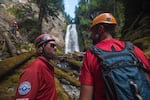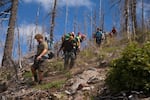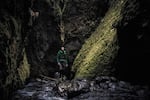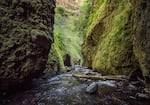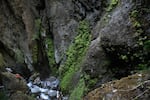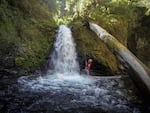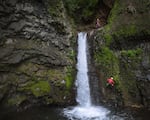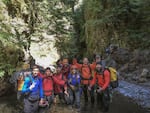The forest is a lush green, tangled with downed logs and whips of vine maple. Mike Malone calls out to the hikers behind him.
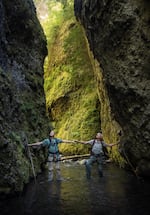
A slot canyon is casually defined as more narrow than tall. Sean Malone, left, and Mike Malone, right, stand at a point in the canyon where it is only two arm spans wide.
Uncage The Soul / OPB
“Watch out, there’s devil's club right here,” he says, pointing to the spiny shrub near his path.
Malone and his companions are pushing their way through miles of rough terrain. It is a tossup if the forest is preferable to the icy cold stream. But crossing through both are necessary to get to Valhalla.
The expedition team puts in 10 hours of hiking before arriving at a previously uncharted slot canyon in the Mount Jefferson Wilderness in the Cascade Range.
"Ah ... There’s Valhalla,” Malone calls out as he crests a massive logjam.
The retired Forest Service employee named this place Valhalla in homage to the enormous, awe-inspiring hall ruled by the Norse god Odin. And like a hall, slot canyons are much deeper than they are wide — caused by a river or a fault.
In the narrowest part of Oregon’s Valhalla, Malone and his adult son, Sean, can link hands and touch both walls that rise nearly 100 feet above them. Malone looks over at his son, who is seeing the canyon for the first time.
“Isn’t that cool?” he asks.
“Finally," Sean says. "It’s been a long time coming,”
A Tale of Discovery
There is not much of the Earth’s landmass that hasn’t been explored; the continents have been mapped, the poles conquered and the mountains climbed. That is what makes Mike Malone’s Valhalla so remarkable. It is a natural wonder about 60 miles from Portland and its 2.3 million metro-area residents. And it had never been documented — until now.
The story of Valhalla’s discovery begins in 2010.
“It was just a combination of all the right things happening together,” Malone says, reflecting back on that day.
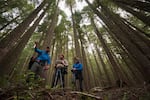
Jared Smith and OPB's Michael Bendixen and Jule Gilfillan scout the landscape around the slot canyon.
Uncage The Soul / OPB
Malone was crew leader on a helicopter working the View Lake wildfire 45 miles east of Estacada, Oregon. He received orders to do a pickup in the Mount Jefferson Wilderness. But the helicopter couldn’t fly straight to its target because of the fire. Instead they took a detour.
“And so as we’re flying along, the smoke was really thick, so we had to drop down and fly up this canyon — just above treetop level,” Malone says.
Related: Descending Into Uncharted Territory
Usually in wilderness, aircraft aren’t allowed to fly low, but there is an exception for wildfire operations. And just as the helicopter flew up a drainage, Malone happened to glance down.
“I see the stream, and then all of a sudden it just disappears into this dark crevice. And then a few seconds later, flying at 90 knots per hour, it opened up again," he says. “I never will forget, I mentioned to the pilot, I go, ‘Wow, we just flew over a slot canyon.’”
When Malone got back to base, he immediately grabbed maps of the area, which he was sure would show something like a slot canyon.
“Usually, significant things in a wilderness — waterfalls, lakes or other geologic features — if there’s anything special about them, they’ll be named on the map,” Malone says.
But to his surprise, none of the maps marked the canyon. This is when Mike Malone’s quest to see the slot canyon in person began.
He started researching, looking for any reference to the canyon or the nearly 100-foot waterfall towering just upstream. And the Forest Service, which has managed the land for more than a century, didn’t seem to know about it either.
He pored over maps, examining topography and possible ways to trek into the steep, trail-less area.
“I’ve been pretty much obsessed with getting here these past four years,” he says.
Slideshow: See Valhalla
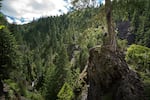
On a second scouting trip, the team, including OPB videographer Michael Bendixen, right, explored a “top-side” route to the terminal waterfall at the top of the Valhalla canyon.
Uncage The Soul / OPB
Malone mounted three initial expeditions to the slot canyon. Each time he got a little bit farther than the previous trek. But it was a fourth last summer, with his son, Sean, and a film crew from OPB, when Malone finally journeyed deep into the Halls of Valhalla.
“Believe me, it’s all he’s been talking about," Sean Malone says. "He has referred to this as the biggest thing of his life lots of times.”
Exploring Valhalla
At the entrance to Valhalla, the river fills the canyon floor. The only way forward is for Mike and Sean to wade through the icy water.
Soon a series of large waterfalls blocks their way. Malone consults Jared Smith, a professional climbing guide who is helping them explore the canyon.
“That’s what makes it so spectacular is just these waterfalls are just one after another," Smith says to Malone. "And that’s what makes it so dangerous and hard to navigate. There’s places in there we’re lucky to get through."
The slot canyon itself is about 200 yards long. Upstream, it opens up and eventually comes to two large waterfalls, about 40 feet apart and both about 100 feet high. The waterfalls are formed when two separate streams flow over the same cliff before coming together to form the river flowing through Valhalla.

The stream that forms the Valhalla canyon merges with another nearby stream to create a glade with two waterfalls that have been nicknamed “Shangri-La.”
Uncage The Soul / OPB
All that water, even at low flow, creates serious hazards to anyone in the canyon. It is fast, cold, steep and slick. Even with Smith’s expert guidance, falls and mishaps are part of the equation.
Now that Mike Malone’s discovery is on the map, so to speak, there is concern that adventure-seekers from all over the world will search the canyon out.
“I mean you can die in here very fast,” says Smith, who is also a wilderness first responder.
Hypothermia and broken bones are real threats. Cellphone service is nonexistent. With the terrain so difficult to access, any rescue attempts would be slow and difficult at best.
“You know everything could be fine. We did great and we got through very gracefully," Smith says. "But at any moment, the smallest of things could have happened and changed everything."
Still, Malone wants to share his discovery with the world and hopes the Forest Service will build a trail to Valhalla.
“It would be a trail to probably the most spectacular feature in the whole Mount Jefferson Wilderness, if not one of the most spectacular features in Oregon,” he says.
But Forest Service Ranger Grady McMahan, whose district includes the Mount Jefferson Wilderness, says building a trail to the slot canyon doesn’t make sense.
“Constructing a trail would be very, very difficult to do. Very expensive. And I don’t know if it would be very safe either," he says. "I really wouldn’t want to lead people into an area where they get in over their head."
McMahan says part of what is special about these protected lands is the remoteness. And even if it were possible in the difficult terrain, building a trail could present a different kind of danger: it would take some of the wild out of the wilderness.

